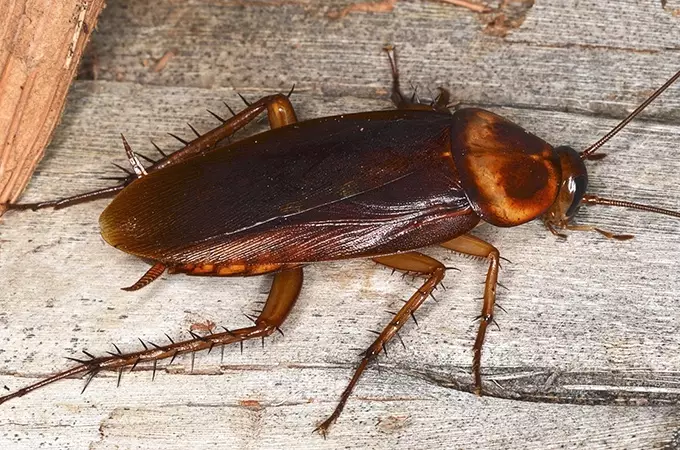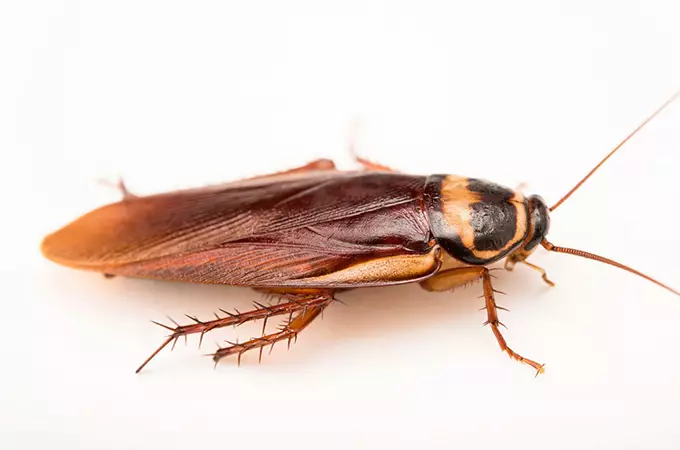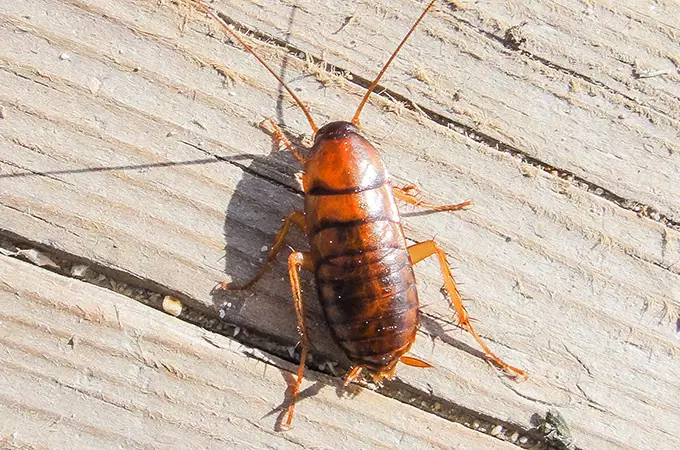Florida Cockroach Identification
Pest Library
What do Cockroaches Look Like?
While different types of cockroaches have different characteristics (more on that later), there are a few distinct characteristics that can help you identify the insect you are seeing in your home as a cockroach
They are between ½” and 3” in length
Usually reddish-black or brown in color
Elongated, oval-shaped, flat bodies
That elongated, oval-shaped, flat form allows cockroaches to navigate tight spaces and crevices, capitalizing on their ability to squeeze through small openings.
Types of Cockroaches in Florida
Florida is unfortunately home to many different types of cockroaches, each of them with slightly different physical characteristics, behaviors, and threat levels. Below we have outlined 5 of the most common roaches found in Florida and detail how they are distinct from one another – and how they are similar.
GERMAN COCKROACHES

What Do German Roaches Look Like?
German roaches are the most predominantly seen roach in Florida dwellings. These roaches are:
- 1/2” – 5/8” in length
- Dark brown
- Have two distinct parallel bands running down their thorax.
Do German Cockroaches Fly?
German cockroaches have wings, but they are (luckily) not strong fliers like some other roach species. They have the ability to fly, but typically rely on their wings only for short glides or to assist in maneuvering and escaping danger.
How do German Cockroaches Get in Your House?
German cockroaches can enter your house through various means, taking advantage of small openings and pathways. Some common ways they may get in includes:
- Infested items such as used furniture, appliances, cardboard boxes, or bags brought in from outside.
- Cracks and gaps: These roaches are adept at squeezing through tiny cracks and gaps in walls, windows, doors, foundations, and utility lines. Even small openings provide an entry point for them.
- Plumbing and drains: German roaches can travel through pipes and drains, especially if there are leaks or openings that lead into your home. They can move between adjacent units in multi-unit buildings through shared plumbing systems.
- Vents and openings: Roaches can enter through ventilation systems, ducts, and openings around utility lines, especially if they are not properly sealed or screened.
What Attracts German Roaches?
These creatures are attracted to warm humid environments that will provide them with food and water sufficient for survival and reproduction. They are omnivores and eat things like:
- Wax
- Gum
- Pet food
- Grease
- Crumbs
- Left-over food in empty cans or containers
- Meat
- Trash and garbage
I’ve Heard German Roaches Bite. Is That True?
German roaches are not typically known to bite humans. They are primarily scavengers and prefer feeding on decaying organic matter, food debris, and other accessible food sources. However, in rare cases, if their population is high and their primary food sources are scarce, they may nibble on fingernails, eyelashes, or calloused skin.
Where Do You Find German Roaches?
German Roaches hide during the day in the dark and moist areas of the building and come out at night to forage for food.
Are German Roaches Dangerous?
German roaches can be extremely destructive inside homes and buildings. They contaminate with their feces and can feed on books, book bindings, and other soft items. They also transport bacteria, germs, and pathogens they picked up from other unsanitary places. German cockroaches also emit a powerful allergen that can aggravate allergies and asthma in some people
American Cockroaches

What Do American Cockroaches Look Like?
The American cockroach is distinct because of its large size – in fact, they are Florida’s biggest cockroach (ick). Measuring between 1-1/2” and 2” in length, this large black and brown flying roach also has very recognizable markings that make them relatively easy to identify: a yellow shield on its head with black markings.
Do American Cockroaches Fly?
Yes. American Roaches have well-developed wings and can fly. They primarily rely on their wings for gliding or short flights, but they are capable of sustained flight over short distances, especially in warm and humid conditions. However, American cockroaches are more inclined to use their wings for escaping danger or finding suitable habitats rather than regular flight.
What Attracts American Cockroaches?
American cockroaches are attracted to warm, humid areas that can provide them with food, and shelter.
What Do American Cockroaches Eat?
They are attracted to all kinds of food, but especially starch, grease, sugar meat, cheese, and trash.
Do American Cockroaches Bite?
American cockroaches have the capability to bite, but it is extremely rare for them to bite humans. Biting incidents are usually limited to situations where they feel threatened or cornered, and even then, their bites are not considered harmful or dangerous to humans.
Where Do American Cockroaches Live?
Indoors, American roaches hide in dark, secluded areas during the day and then come out at night to look for food and water. Outdoors, the Florida Palmetto Tree is their favorite den. They are also attracted to warm, damp areas–under mulch and in flower beds. In city settings, American roaches are also very common in sewer systems. Extreme weather (very wet, very dry) will drive these roaches indoors.
Are American Cockroaches Dangerous?
Yes, and no. The damage that American roaches inflict on humans is mostly emotional: these large flying roaches put fear in the hearts of most Floridians. However, they can be a health danger – because they frequent filthy places like sewers and garbage cans, they can pick up pathogens and germs that hitch a ride into your home, including Salmonella, E. coli, and Streptococcus.
Australian Cockroaches

What Do Australian Cockroaches Look Like?
Australian roaches are often mistaken for the smaller (1-1/4”) American Roach. However, they are distinct from American Cockroaches in a few ways:
- Size: They can measure approximately 1 to 1.5 inches in length.
- Coloration: They have a dark brown or mahogany color, often described as “smoky brown”.
- Wings: Australian cockroaches possess fully developed wings that extend beyond the length of their bodies. These wings enable them to fly, although they are not strong fliers and prefer to glide short distances.
When are Australian Roaches Most Active?
Like many roaches, Australian roaches are nocturnal. They come out at night to hunt for food and water and during the day they hide away in dark, moist areas.
What Attracts Australian Cockroaches?
Australian roaches are attracted to light sources and moisture-rich areas.
Where Are You Likely to Find Australian Cockroaches?
These roaches prefer to be outside. If they are indoors, it is likely because they have accidentally been brought in by the homeowner via a cardboard box, potted plant, etc.. Outdoors, they are usually found:
- Under tree bark
- In piles of firewood and mulch
- In gardening beds
- Under rocks
Do Australian Roaches Fly?
Yes, Australian cockroaches are capable of flying. They have well-developed wings that allow them to fly relatively long distances compared to other cockroach species. However, while they have the ability to fly, they are not strong fliers and prefer to glide rather than engage in sustained flight.
Are Australian Roaches Dangerous?
Australian roaches are both dangerous and destructive. Once an Australian roach is indoors, they have been known to eat holes in clothing and feed upon household items like book covers, making them quite destructive. And, in true roach fashion, these creatures come in contact with some nasty germs and disease-causing pathogens in their travels through sewers and trash, which they then so generously leave on your counters, in your pantry, and all over your home. This puts Australian roaches in the “danger column” for health risks.
Brown-banded Cockroaches

What do Brown-Banded Cockroaches Look Like?
The brown-banded roach is a small, 1/2” long, oval-shaped brown roach that has two lighter bands of brown across its body. Males have a full set of wings that reach out beyond their abdomen and females have a set of smaller underdeveloped wings.
Can Brown-Banded Cockroaches Fly?
Yes, brown-banded cockroaches have the ability to fly. Both male and female brown-banded cockroaches possess wings, allowing them to engage in flight. However, it’s important to note that they are not strong fliers compared to other cockroach species.
When are Brown-Banded Roaches Most Active?
Brown-banded roaches are most active at night but have been seen wandering around during the day in search of food when necessary.
What Attracts Brown-Banded Roaches?
These roaches are a bit different than most of the other roaches in Florida, where in they prefer a drier environment. They still tend to inhabit areas that are warm (70 to 80 degrees Fahrenheit) but are also much drier than the places other roaches inhabit.
Do Brown-Banded Cockroaches Bite?
Brown-banded cockroaches do not possess biting mouthparts adapted for feeding on human blood or causing harm to humans. While it is possible for them to come into contact with humans, they generally try to avoid direct interaction and are more likely to flee or seek shelter when disturbed.
Where are You Likely to Find Brown-Banded Roaches?
The brown-banded roach is mostly found congregating on ceilings, around appliance motors, and in attics. These smaller roaches can also be found under furniture.
Are Brown-Banded Roaches Destructive?
Brown-banded roaches are opportunistic feeders and will eat household materials like book bindings and wallpaper glue which can be extremely destructive in certain environments. They also pick up germs on the spines of their legs and deposit them elsewhere bringing diseases and viruses indoors wherever they may travel.
Asian cockroaches

WHAT DO ASIAN COCKROACHES LOOK LIKE?
Asian roaches are similar to the German Cockroach, and the two are often mistaken for one another. Asian roaches are usually 5/8” to 1”, brown, and have long, narrow wings that extend beyond the tip of their abdomen. These wings enable them to be strong and agile flyers both indoors and out. They also have a groove on the segment of their abdomen that is a different shape than that of a German roach.
WHEN ARE ASIAN COCKROACHES MOST ACTIVE?
Asian roach populations usually hit their peak in the spring and summer months. Day-to-day, these roaches are most active at night.
WHAT ATTRACTS ASIAN ROACHES?
Asian roaches are attracted to light and- despite being omnivores- prefer to seek out plant materials such as aphid honeydew and flowers. Asian roaches fly readily and are attracted to light.
WHERE ARE YOU LIKELY TO FIND ASIAN ROACHES?
Asian roaches prefer to be outdoors and are commonly found in shaded, moist areas.
ARE ASIAN ROACHES DANGEROUS OR DESTRUCTIVE?
Asian roaches are a typical roach when it comes to being dangerous and destructive. They regularly visit areas of great germ potential like garbage dumps and sewers, where they pick up germs on their bodies and then transport them to places where people, live, eat and prepare food. This habit of roaches causes them to be of great health concern. They are also destructive in their habits of leaving their waste behind them on your food and possessions.
THE SIGNS OF A COCKROACH INFESTATION
Some common signs that may indicate a cockroach infestation include:
Live Cockroach Sightings: Spotting live cockroaches, especially during the daytime, is a clear indication of an infestation. Cockroaches usually hide during the day and become active at night, so seeing them during daylight hours can suggest a large population.
Droppings: Cockroach droppings, often resembling small black or dark brown specks, can be found in areas where cockroaches frequent. These droppings may appear similar to coffee grounds or pepper flakes and are typically found in corners, cabinets, drawers, or along baseboards.
Foul Odor: Cockroaches emit a distinct, musty odor that can become noticeable in areas with a significant infestation. The odor is often described as a strong, unpleasant, or oily smell.
Egg Casings (Oothecae): Cockroach egg cases, known as oothecae, are left behind by female cockroaches. These cases can be found in hidden areas such as cracks, crevices, behind furniture, or inside appliances. They are often brown or tan in color and can contain multiple eggs.
Shed Skin: As cockroaches grow, they shed their exoskeletons. Finding discarded exoskeletons, known as exuviae, can indicate the presence of cockroaches and their active reproduction.
Damage to Materials: Cockroaches can cause damage to various materials, including food packaging, books, papers, and fabrics. Look for signs of gnaw marks, small holes, or damage to these items.
Grease Smears: Cockroaches leave behind oily or greasy smears on surfaces as they navigate through their environment. These smears may appear as dark streaks or smudges on walls, floors, or other surfaces.
Nests or Harborages: Cockroaches typically seek out dark, hidden areas to rest and breed. Check for signs of cockroach nests, such as small piles of debris, egg casings, or a buildup of droppings in secluded areas.
COCKROACH PREVENTION TIPS
Preventing cockroaches from infesting your home involves implementing a combination of proactive measures. Here are some tips to help prevent cockroaches:
- Maintain Cleanliness: Keep your home clean and free of food debris. Clean up spills immediately, wipe down countertops, sweep or vacuum regularly, and dispose of garbage in sealed containers. Pay attention to areas like the kitchen, dining area, and other spaces where food is prepared or consumed.
- Store Food Properly: Seal food in airtight containers to deny access to cockroaches. Avoid leaving food uncovered or exposed on countertops or tables. Pet food should also be stored securely.
- Remove Clutter: Minimize clutter and piles of paper or cardboard, as these provide hiding places for cockroaches. Regularly declutter and organize storage areas.
- Seal Entry Points: Inspect your home for potential entry points and seal any cracks, gaps, or openings in walls, floors, or foundations. Pay close attention to areas where pipes or utility lines enter your home.
- Fix Leaks and Reduce Moisture: Cockroaches are attracted to moisture. Repair any plumbing leaks, fix dripping faucets, and ensure proper drainage. Use dehumidifiers in areas prone to high humidity.
- Properly Ventilate: Ensure adequate ventilation in areas such as bathrooms, kitchens, and basements. Proper airflow can help reduce moisture buildup.
- Regularly Clean Appliances: Clean behind and under appliances, as well as inside cabinets and drawers, to eliminate food particles and hiding spots.
- Keep the Exterior Clean: Remove debris, leaf piles, and standing water from your yard or outdoor areas. Trim vegetation away from the house to minimize entry points.
- Inspect Used Items: Before bringing used furniture, appliances, or boxes into your home, inspect them carefully for signs of cockroaches or their egg cases.
- Professional Pest Control: Consider seeking professional pest control services for preventive treatments and regular inspections, especially if you live in an area prone to cockroach infestations.